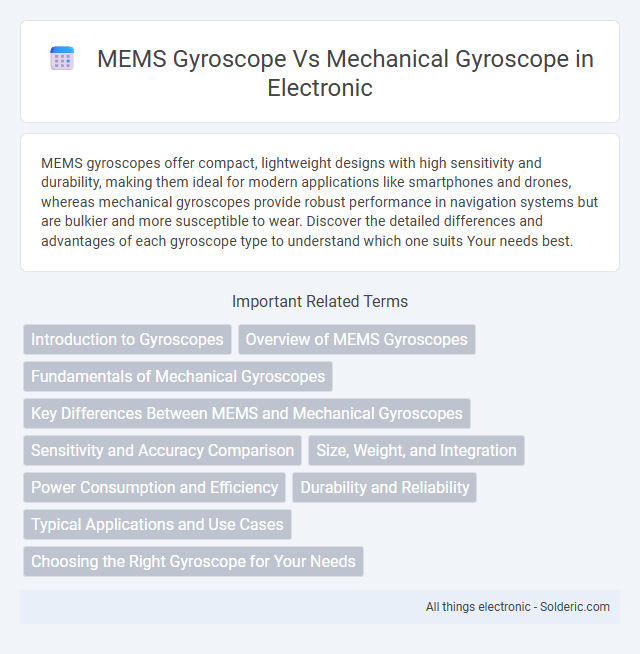MEMS gyroscopes offer compact, lightweight designs with high sensitivity and durability, making them ideal for modern applications like smartphones and drones, whereas mechanical gyroscopes provide robust performance in navigation systems but are bulkier and more susceptible to wear. Discover the detailed differences and advantages of each gyroscope type to understand which one suits Your needs best.
Comparison Table
| Feature | MEMS Gyroscope | Mechanical Gyroscope |
|---|---|---|
| Size | Compact, micro-scale | Bulky, large |
| Weight | Lightweight (few grams) | Heavy (hundreds of grams to kg) |
| Durability | Robust, shock-resistant | Fragile due to mechanical parts |
| Power Consumption | Low (mW range) | High (due to spinning rotor) |
| Accuracy | Moderate, improved with calibration | High, stable over time |
| Response Time | Fast, real-time sensing | Slower due to mechanical inertia |
| Cost | Low, mass-producible | High, complex manufacturing |
| Applications | Consumer electronics, drones, automotive | Aerospace, maritime, military navigation |
Introduction to Gyroscopes
MEMS gyroscopes utilize microelectromechanical systems technology to measure angular velocity with high precision and compact size, making them ideal for consumer electronics and automotive applications. Mechanical gyroscopes rely on spinning rotors and gimbals to detect orientation through angular momentum, providing durability and stability in aerospace and marine navigation. Your choice depends on the required accuracy, size constraints, and environmental conditions for the application.
Overview of MEMS Gyroscopes
MEMS gyroscopes use micro-electromechanical systems technology to detect angular velocity by measuring Coriolis forces on vibrating structures, offering compact size and low power consumption. Mechanical gyroscopes rely on spinning rotors to maintain orientation based on angular momentum, resulting in larger and heavier devices with higher maintenance needs. MEMS gyroscopes enable integration into consumer electronics, automotive stability control, and drones due to their miniaturization and cost efficiency compared to traditional mechanical gyroscopes.
Fundamentals of Mechanical Gyroscopes
Mechanical gyroscopes rely on a spinning rotor mounted on gimbals to maintain orientation based on angular momentum principles, resisting changes in direction due to external forces. This fundamental design provides high precision and stability in navigation systems but involves larger size, weight, and mechanical complexity compared to MEMS gyroscopes. Your choice depends on the application's need for durability and accuracy versus miniaturization and cost-efficiency.
Key Differences Between MEMS and Mechanical Gyroscopes
MEMS gyroscopes utilize microelectromechanical systems technology to detect angular velocity using vibrating structures, enabling compact size and low power consumption compared to traditional mechanical gyroscopes that rely on spinning rotors to sense rotational movement. MEMS gyroscopes offer faster response times, higher resistance to shock and vibration, and greater integration potential in consumer electronics, whereas mechanical gyroscopes deliver superior precision and stability in high-performance applications like aerospace and navigation. The cost-effectiveness and scalability of MEMS gyroscopes make them ideal for mass-market devices, while mechanical gyroscopes maintain relevance where accuracy and durability under extreme conditions are paramount.
Sensitivity and Accuracy Comparison
MEMS gyroscopes offer higher sensitivity due to their ability to detect minute angular velocity changes through microfabricated vibrating structures, delivering precision suitable for consumer electronics and automotive applications. Mechanical gyroscopes rely on spinning rotors and inertial principles, providing robust accuracy but often suffering from larger size, slower response times, and susceptibility to mechanical wear. Your choice should weigh MEMS gyroscopes' enhanced sensitivity and compactness against the mechanical gyroscopes' proven stability and traditional accuracy in demanding environments.
Size, Weight, and Integration
MEMS gyroscopes offer significantly smaller size and lighter weight compared to mechanical gyroscopes, making them ideal for compact and portable applications. Their microfabricated components enable seamless integration with electronic circuits and digital systems, enhancing performance and reducing overall system complexity. Mechanical gyroscopes require larger, heavier components and separate housing, limiting their scalability and integration potential in modern electronics.
Power Consumption and Efficiency
MEMS gyroscopes consume significantly less power than mechanical gyroscopes, making them ideal for battery-operated devices such as smartphones and wearables. Their efficient micro-scale design reduces energy loss while maintaining high precision and stability in motion sensing. You benefit from extended device battery life and enhanced performance when opting for MEMS gyroscopes over traditional mechanical options.
Durability and Reliability
MEMS gyroscopes offer superior durability compared to mechanical gyroscopes due to their solid-state design with no moving parts, reducing wear and tear from mechanical stress. Their reliability excels in harsh environments, maintaining performance under shock, vibration, and temperature variations where mechanical gyroscopes often suffer degradation. Long-term stability of MEMS gyroscopes supports consistent output, making them ideal for applications requiring extended maintenance intervals and high operational uptime.
Typical Applications and Use Cases
MEMS gyroscopes are widely used in consumer electronics such as smartphones, drones, and gaming controllers due to their compact size, low power consumption, and cost-effectiveness. Mechanical gyroscopes find typical applications in aerospace navigation, marine systems, and precision instrumentation where high stability and accuracy are critical. Your choice depends on whether miniaturization and affordability or ruggedness and precision are more important for the specific use case.
Choosing the Right Gyroscope for Your Needs
MEMS gyroscopes provide compact size, low power consumption, and cost-effectiveness, making them ideal for consumer electronics, drones, and automotive applications where space and efficiency matter. Mechanical gyroscopes offer superior precision and stability under harsh conditions, preferred in aerospace and marine navigation where accuracy is critical. Assess your application's requirements for accuracy, size, power, and budget to choose the right gyroscope for your needs.
MEMS gyroscope vs mechanical gyroscope Infographic

 solderic.com
solderic.com